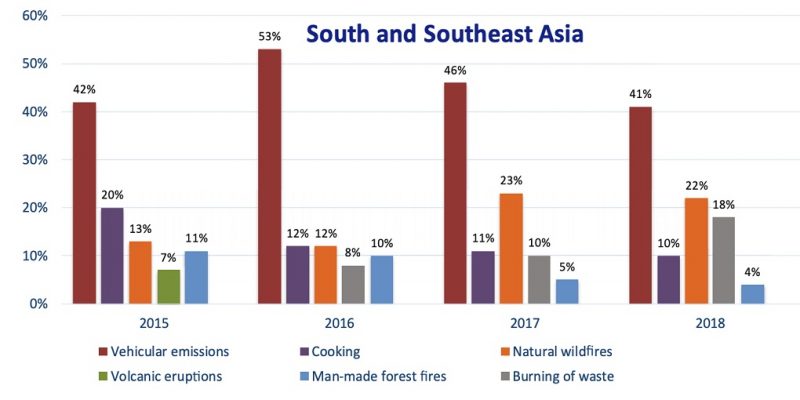05 April 2019
Public misunderstandings about the cause and impact of air pollution are being driven by poor media reporting in South and Southeast Asia, a new study finds.
The media in South and Southeast Asia has helped to build a hazy public perception of air pollution by reporting it superficially, insufficiently or incorrectly, says a new report by Vital Strategies, a US-based public health institution.
The report titled ‘Hazy Perceptions’ analyses more than half a million social media posts between 2015 to 2018 in India, Sri Lanka, Nepal, Philippines, Papua New Guinea, Indonesia, Thailand, Malaysia, Singapore, Mongolia, and Pakistan. “Our report finds that public perceptions about air pollution do not match the evidence,” said Anchal Mehta, a member of the study team.

Air pollution causes more than 4 million deaths each year globally. South and Southeast Asia account for around 1.5 million – or 37% – of these deaths.
Most important drivers of air pollution ignored
The most important sources of pollutants, such as household fuels, power plants, and waste burning, receive less public attention than sources such as vehicular emissions, the report found.
A recent study by Clean Air Collective in India showed that 90% of Indians interviewed across highly polluted cities do not understand the causes and effects of air pollution. “This could be partly because of media coverage that doesn’t reflect the current evidence and science,” the report says. Less significant sources of air pollution such as vehicular emissions are mentioned more frequently than more significant sources like power plants and waste burning.
Another study carried out by Vital Strategies in India in 2014 and 2015 showed that the majority of news about air pollution omitted information about the major health impacts or the effect on vulnerable populations.
In India, focus on vehicle emissions was disproportionately high compared to other sources. The debate was dominated by the Delhi government’s odd-even number plate rule (restricting which cars can be on the road on what day), with vehicle pollution understood as the number one pollution source. Vehicle pollution was still seen as a number one source in other countries as well, followed by cooking and natural wildfires.
“There is a gap between commonly discussed sources and actual sources of air pollution. Although power plants, burning fossil fuels, and waste burning are major sources for air pollution in many countries, they do not show up among top sources,” the report added. Even though the 2015 haze from forest fires that affected Singapore, Malaysia, and Indonesia was widely reported, vehicle pollution remained the most discussed source of air pollution that year.

Long term health impacts ignored
The media has also focused on short-term health effects rather than more serious long term threats of air pollution. “News and social media posts largely mention short-term health impacts such as coughing or itchy eyes, far more than health threats caused by chronic exposure, such as cancer,” the report claims.
Beyond deaths, air pollution causes disability from lung and heart disease, contributes to diabetes, inhibits physical activity, and negatively influences children’s physical and cognitive development. Between 2015 and 2018, most of the conversations in the media and social media mention acute symptoms (75%) while mentions of chronic illness were less frequent (25%).
“This reflects an important gap in awareness of air pollution exacerbation of chronic cardiovascular and lung diseases, which account for the vast majority of deaths from air pollution,” said Kass.

How to influence the debate?
The report recommends evidence-based communication campaigns to highlight the most significant sources of air pollution and to address the health hazards of long-term exposure. “Another critical step is ensuring that media professionals and key advocates for clean air are informed about credible data on the sources of air pollution, its health impact, and solutions, said Mehta.
Interestingly, the report says the public health authorities do not influence the conversation on air pollution, but a photographer, international NGO Green Peace and an activist were on top leading influencers list.
Air pollution is most frequently discussed from September through December when air quality is worsened by the winter season and crop burning practices adopted by farmers. The report has pointed out the seasonal reporting as a challenge for engaging the public to support effective air pollution control, which requires year-round, sustained measures.
The report also found that the posts about the effect of air pollution on children received more engagement on social media.
“There is a clear disconnect between public understanding of air pollution and reality. While people are aware of the problem, there is a need to elevate concern about the impacts of air pollution on human health as well as the environment,” Mehta added.
Link: https://thewire.in/environment/asian-media-misleads-public-on-air-pollution